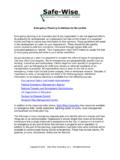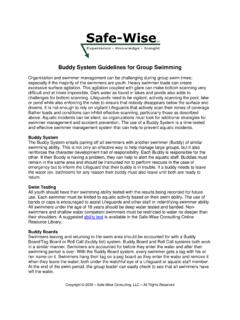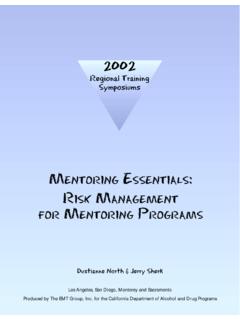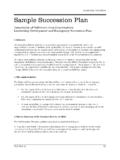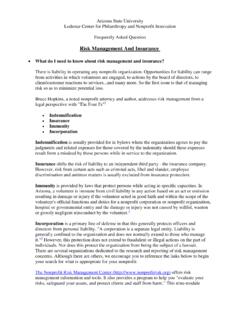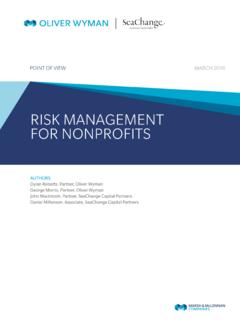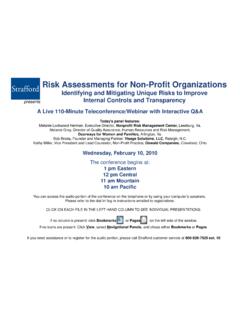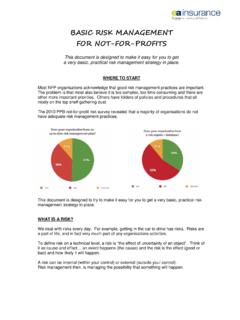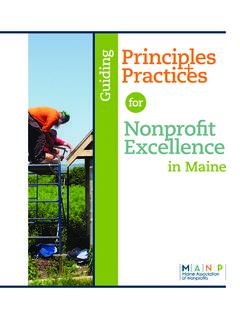Transcription of Managing Risks at the Hometown YMCA By Mike Gurtler, Safe …
1 Managing Risks at the Hometown YMCA By Mike Gurtler, Safe-Wise Consulting It has been nearly two decades since I stepped into the role as CEO of a small rural YMCA. It was a great small town (still is) with a Y that had been around for nearly 100 years. I was the first Y professional to lead the organization and I soon learned that many of the resources I had become accustomed to working with at larger, more metropolitan, YMCAs were not as accessible to me. At the time I was all optimism and vigor so I found ways to get the support I needed from a variety of places; thanks goodness for youthful enthusiasm and good mentors. When I reflect on those experiences as I work with YMCA leaders today it helps me remember the challenges that are faced by the many leaders that make up the largest segment of the YMCA movement; smaller YMCAs. Twenty years ago I had never really thought of risk management as a discipline within my management of a YMCA.
2 Heck, I don t remember when I first heard the term applied to a YMCA. Today it flies out of my mouth probably all too often, but I still remember the things that helped me as a CEO. Risk management in the YMCA has grown since my early CEO days and I have been fortunate enough to learn, grow and be successful as this enlightenment has become part of the YMCA movement. And while risk management might be commonly discussed or recognized as a term, it can still be a challenge for smaller YMCAs. This is not because of the lack of interest, but is often because many leaders of small YMCAs have not found the resources they need to be successful in their risk management efforts, or simply are overwhelmed with day-to-day and do not see how risk management fits in. Training for Y leaders in risk management is often only available from the School of Experience , small workshops, conferences and from sources outside the movement.
3 Obviously everyone has a lifetime enrollment in the School of Experience , but learning on the fly or after the fact is not always the best way to manage Risks . With this in mind I will discuss a number of valuable resources later in this article. These can be easily accessed by any Y leader to learn more about risk management in order to make their efforts more effective and practical. When I first started working for the YMCA in the early eighties I learned that networking and access to training, new ideas and the talents of others were some of the keys for me to be successful. I was lucky enough to be in an area that had great YMCA networks and a very active APD (now AYP) chapter. A month did not go by without an opportunity to learn. I was also fortunate to work for organizations that invested in me through training and professional development. This is not always the case in more rural locations and at small YMCAs where budgetary constraint and distance can make access to training and resources difficult.
4 But access is not impossible. It takes commitment and understanding, but there are benefits to learning more about risk management . Learning on this topic does not need to be the exclusive of the CEO; other staff should be exposed to risk management concepts as well. The benefits of risk management can be cost savings, stronger staff, safer families and communities and an increased ability for your YMCA to provide its mission. Ys with a better understanding of risk management tend to be well managed, more organized and have greater staff involvement and morale at all levels. The processes involved in good risk management are the same as those needed for a YMCA to grow, be effective and sustain excellence. But let me step down off my soapbox to get to the main purpose of this article and help identify resources that can be accesses to make your YMCA risk management efforts effective. Where do I start? YMCA Exchange can be a starting point for your risk management growth and understanding.
5 The risk management page within the operations section of Exchange has quite a selection of resources to get you started on your journey into raising your awareness and developing new skills. The page lists links to a variety of sample resources such as guidelines, policies and training outlines. The page also links to a number of online training tools that were developed by the nonprofit Risk management Center specifically for Y-USA. Exchange also houses operating guidelines for YMCAs that can help you benchmark your risk management efforts. These include the child abuse prevention checklist, essential aquatic safety guidelines and YMCA best practices. The nonprofit Risk management Center (NRMC) is a nonprofit organization dedicated to helping other nonprofit organizations successfully manage Risks . They work with nonprofits of all sizes across the US. While not all their resources are YMCA specific, NRMC is Y-USA s preferred partner for risk management and they are the national leader in risk management for nonprofits.
6 NRMC hosts a wide variety of resources on their Website ( ), regularly publishes articles applicable to YMCA work in their e-news and hosts both regional and national conferences on risk management . Who do I call? Now that you ve perused some resources and are excited to further progress in your risk management journey let s look at who can help you learn more. Okay, so maybe you re not exactly excited about it, but are still interested in learning more. Insurance professionals are generally a good resource for risk management support. People like your insurance agent, worker s comp program representative, loss control specialist (from your insurer) and your insurance company or program can often provide advice, tools, training and support that will strengthen your risk management efforts. Other YMCA leaders can often provide support and insight that can really help their colleagues along; many of them have already learned from the School of Experience.
7 This is one reason that participation in networks and neighborhoods is truly important. These events can provide great information and it is often the discussion over lunch that provides the tools needed for success. Can t get to an event or meeting on a regular basis? Why not create a learning circle or e-mail group to help out then? I wish I had e-mail when I first worked in the Y. Larger Ys in your area may have a risk manager as part of their staff that can also be a great wealth of knowledge. Your Y-USA Resource Director can also assist in identifying sources for support and information. What do I do first? Now that you ve searched out resources and sources for support it is time to make a plan for effective management . This does not need to be a stand-alone plan; risk management can easily be incorporated in most management structures and operating plans. Your plan should include a structure of responsibility.
8 I know that the CEO of a small Y wears many if not all the hats, but you d be surprised to see how many employees (full and part-time) and volunteers can embrace risk management responsibilities. Maybe it is a local EMT that helps to regularly inspect first aid equipment and supplies or offers to assist with emergency planning and drills. It could be the child care staff that embrace the importance of youth protection practices and then provide the training and direction for your organization s efforts to protect youth, families, staff, the community and the organization from the harm that comes from child abuse. Your Board committees often can take on risk management functions such as financial control, facility maintenance, policy development and program review. As the CEO of a small Y you may take the leadership role for risk management , but also remember that it is a team effort that will work the best. Heck, why not go crazy and form a safety or risk management committee made up of volunteers and staff.
9 The culture of safety created by such a group can help drive quality programs, services and facilities for your organization. As you develop a plan to manage Risks and operate safely there are some general areas for YMCAs that you should look at. Aquatic Safety While there are certainly more slips and falls at YMCAs then there are aquatic incidents, the severity of a possible drowning or near-drowning makes us look at this topic in our plan. Aquatic safety efforts include staff selection and training, supervision, facilities, equipment and strong policies with effective procedures. Child Abuse Prevention Your plan should include strategies that protect children, staff and the organization. Child Abuse Prevention has no single prevention technique; several types of strategies must be embraced throughout the organization in order to reduce the opportunities for abuse. Emergency Preparedness Action during times of crisis can often affect the final outcome of critical situations; being prepared for possible emergencies and crisis takes planning and practice.
10 Your plan should help you prepare for emergencies with policies, procedures, training and a regular drill program. Facilities Facility issues can often lead to accidents and losses. Key areas such as life-safety, maintenance, prevention and inspection practices should be included in your plan. Financial Control YMCAs must be good stewards of the monies they receive. This includes incorporating sound financial controls into their daily activities as well as implementing policies that help the organization manage its finances. Governance Your Board is the authority when it comes overseeing your organization. Their responsibility for implanting proper polices for staff to implement is important. Risk Transfer Your plan should include the use of waivers, contracts, agreements and other risk transfer vehicles to help protect your organization. Staff Safety Ys can prevent and reduce accidents by developing a culture of safety with staff.
